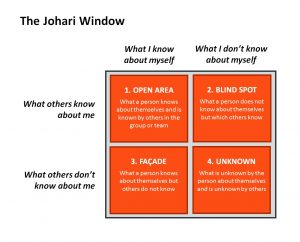 One of the simplest and most useful tools you’ll come across in business is the Johari Window.
One of the simplest and most useful tools you’ll come across in business is the Johari Window.
Devised by American psychologists Joseph Luft and Harry Ingham in 1955 while researching group dynamics at the University of California Los Angeles (UCLA), its odd name is an amusing contraction of their first names: Joe + Harry = Johari.
At its most basic, the Johari Window helps people understand their self-perception and the perception others have of them, by organising information into a four-square matrix, based on two opposing axes:
- What a person knows or doesn’t know about themselves, and
- What others know or don’t know about that person.
When merged, the resulting quadrants define a person in four perspectives, known as areas (also windows or panes). This understanding of oneself can help in many ways, in particular, for developing and training individuals and teams; for increasing effective communications among leaders, managers and team members; and for establishing and understanding group dynamics and inter-group relationships.
The four areas are:
- Open Area – What a person knows about themselves and is known by others in the team or group
- Blind Spot – What a person does not know about themselves but which others know
- Façade – What a person knows about themselves but others do not know
- Unknown – What is unknown by the person about themselves and is unknown by others
 The Open Area
The Open Area
The Open Area is an area of commonly known information about a team member – their behaviour, feelings, attitudes, emotions, skills, experiences and views – which is understood and accepted by the person and their group.
A primary goal for a person working in a team or group should be to develop and expand their Open Area as fully as possible. When a person works in this Open Area, they tend to be at their most effective and productive. Successful Open Areas are based on good communications, non-judgmental feedback, and team cooperation. Likewise, successful Open Areas are free from distractions, mistrust, confusion, conflict and misunderstanding.
People in established teams tend to have larger Open Areas than new team members. New team members start with small Open Areas because they probably haven’t shared much about themselves and established team members don’t fully know the new person.
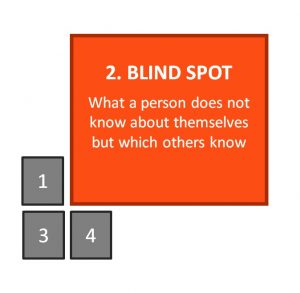 The Blind Spot
The Blind Spot
The Blind Spot is what is known about a person by others in the team, but is unknown by the person themselves. The Blind Spot may be:
- Ignorance about oneself
- Areas where a person’s self-perception is deluded, exaggerated or limited, perhaps by a lack of confidence or self-respect, or by ego and false entitlements
- Areas where others are deliberately withholding information about this person
The goal should be to expand the Open Area horizontally into the Blind Spot, by seeking and listening to feedback from all team members so they better know and understand themselves.
Team members can help a new team member expand their Open Area (and reduce their Blind Spot) by offering constructive, discrete feedback.
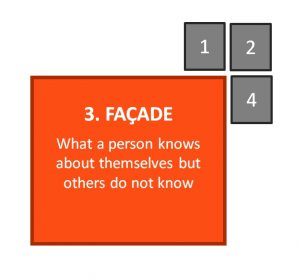 The Façade
The Façade
The Façade is the hidden (or avoided) self, representing information and feelings that a person knows about themselves but does not reveal or is deliberately kept hidden from others. These hidden areas could include sensitivities, fears, hidden agendas, manipulative intentions or secrets that a person does not want to reveal, for whatever reason.
While it’s natural to keep some personal and private information hidden, it’s also typical that most hidden information is not personal. It is work or professionally oriented. So, this knowledge is better positioned in the Open Area.
The goal is disclosure by the individual, which moves hidden information into the Open Area. By telling others how one feels as well as sharing other information, the Blind Spot reduces, leading to better understanding, cooperation, trust and higher productivity. Reducing hidden areas also reduces the chance for confusion and misunderstanding. Team leaders and members may also offer feedback, but it must be done to avoid emotional upset.
Above all, the extent to which a person reveals information about themselves must always be at their discretion.
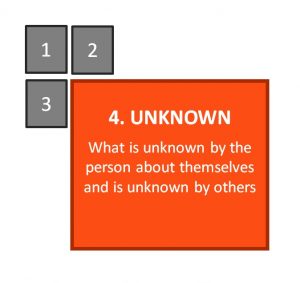 Unknown
Unknown
The Unknown area contains information, feelings, latent abilities, aptitudes and experiences that are unknown to both the person and the team. Large Unknown areas are typically expected in younger team members, or people who lack experience or self-belief. Older or mature people tend to have smaller Unknown areas.
Some of those factors included in the Unknown area may be:
- An ability that is underestimated or untried through lack of opportunity, encouragement, confidence or training
- A natural ability or aptitude that a person doesn’t know they possess
- A fear or aversion that a person doesn’t know they have
- An unknown illness
- Repressed or subconscious feelings, or conditioned behaviour from childhood
Whether Unknown knowledge moves into the Open Area depends upon who discovers it and what they do with that knowledge. The extent and depth of what one does with discovered feelings must be at their discretion. Some people are more willing and able to do this than others.
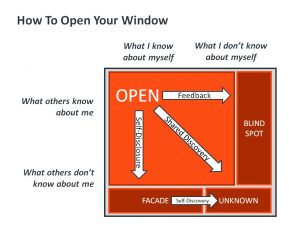 How To Open Windows
How To Open Windows
The Open Area can be expanded horizontally into the Blind Spot if the individual seeks and actively listens to constructive feedback from the team members.
The Open Area can be expanded vertically into the Façade if the individual discloses relevant and appropriate information and feelings to their team members, who should be non-judgmental and accepting of this constructive information.
The Open Area can be expanded diagonally into the Unknown by working with the team leader or other team members in shared discovery, looking into new areas of opportunity to try, with little to no pressure to immediately succeed, or to be accepting of mistakes and errors along the way.
Team members can help a new person expand their Open Area by offering constructive, discrete feedback, or by asking questions of the new person. More so, team leaders can play the biggest role by:
- Promoting a culture and expectation for openness and honesty
- Encouraging positive and constructive communications and feedback
- Challenging people with new opportunities to discover their hidden or unknown talents
In the end, a team which understands itself – that is, each person has a strong mutual understanding of themselves and their role with the team – is far more effective than a team which does not understand each other.
How else might you have tried the Johari Window? I’d love to hear some of your experiences using it in workplace situations.
A reminder too, if you’d like to receive future posts, please scroll to the black menu at the bottom of this page and sign-up using the green Subscribe button. As always, many thanks for reading!

No comment yet, add your voice below!